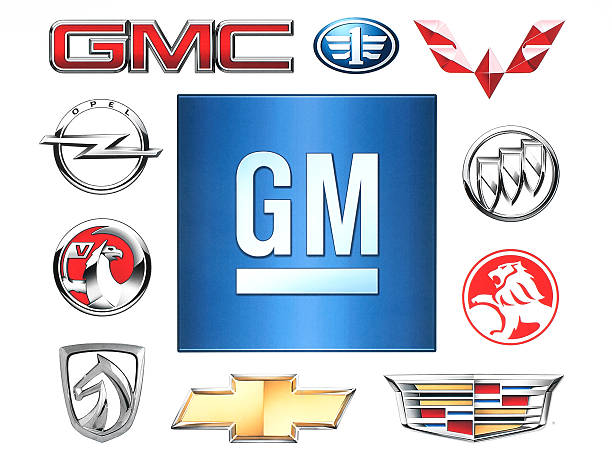General Motors Stock Surges 10% on Dividend Hike & $10 Billion Buyback Announcement

General Motors (NYSE:GM) reaffirmed its earnings guidance for 2023, maintaining its net income forecast in the range of $9.1 billion to $9.7 billion. Additionally, the automaker announced a significant 33% increase in its dividend for 2024 and unveiled plans for a substantial $10 billion accelerated share buyback program. This led to a more than 10% surge intra-day today in General Motors’ shares.
The company also reiterated its adjusted earnings per share (EPS) guidance for the year, expecting it to be between $7.20 and $7.70. The guidance for adjusted EBIT (earnings before interest and taxes) remains set between $11.7 billion and $12.7 billion. GM's Chair and CEO Mary Barra commented on the company's strong profit outlook for 2023, attributing it to GM's exceptional range of vehicles and disciplined operations.
Furthermore, GM updated its capital expenditure forecast for the full year 2023 to be between $11 billion and $11.5 billion, which is at the lower end of its previous guidance. This adjustment is a result of the rescheduling of certain product programs and more efficient capital investments.
| Symbol | Price | %chg |
|---|---|---|
| 005389.KS | 202500 | -4.94 |
| 005380.KS | 276000 | -5.62 |
| 005385.KS | 203500 | -4.67 |
| 005387.KS | 206000 | -5.1 |

Piper Sandler Maintains Neutral Rating on General Motors (NYSE:GM)
- Piper Sandler has maintained its Neutral rating for General Motors (NYSE:GM), raising the price target from $48 to $66.
- General Motors has experienced a strong earnings rally, driven by a positive outlook for the U.S. consumer market, despite challenges in the electric vehicle sector.
- GM's stock has reached a three-year high, with its market capitalization standing at approximately $63.82 billion and a notable trading volume.
On October 21, 2025, Piper Sandler maintained its Neutral rating for General Motors (NYSE:GM), advising investors to hold their positions. At the time, GM's stock was priced at $67.30. Piper Sandler also raised GM's price target from $48 to $66, reflecting a more optimistic outlook for the company's future performance.
General Motors has recently experienced a strong earnings rally, as noted by Ivan Feinseth, driven by a positive outlook for the U.S. consumer market. This rally suggests that despite challenges like tariffs, the U.S. consumer market remains robust. Feinseth's optimism extends beyond the automobile sector, indicating broader economic confidence.
GM's impressive earnings have surpassed expectations, leading to a raised outlook. This performance has pushed GM's stock to a three-year high, despite ongoing challenges in its electric vehicle (EV) business, as highlighted by Marley Kayden. The company's ability to navigate tariff impacts has been better than anticipated, with a revised forecast for tariff costs now between $3.5 billion and $4.5 billion, down from the previous $4 billion to $5 billion range.
Currently, GM's stock price is $67.04, marking a 15.58% increase. The stock has fluctuated between $62.36 and $67.55 today, with the latter being its highest price in the past year. GM's market capitalization stands at approximately $63.82 billion, with a trading volume of 32.77 million shares on the NYSE.

General Motors (NYSE:GM) Surpasses Earnings Expectations with Strong Quarterly Performance
- General Motors (NYSE:GM) reported an impressive EPS of $2.80, beating the estimated $2.29.
- The company's revenue reached approximately $48.6 billion, surpassing the expected $45 billion.
- GM's strategic adjustments, including managing tariff costs and revising electric vehicle (EV) production, have positively impacted its financial outlook and stock price.
General Motors (NYSE:GM) is a leading automaker known for its wide range of vehicles, including electric and traditional models. The company competes with other major players like Ford and Toyota. On October 21, 2025, GM reported impressive earnings per share (EPS) of $2.80, surpassing the estimated $2.29. This strong performance is supported by a revenue of approximately $48.6 billion, exceeding the estimated $45 billion.
Despite a slight decrease from the $2.96 EPS reported in the same quarter last year, GM's current EPS of $2.80 still outperformed the Zacks Consensus Estimate of $2.28. This achievement is partly due to GM's strategic decision to revise its expectations regarding tariff costs, which are now anticipated to be less burdensome. Additionally, higher vehicle prices have contributed to the company's improved financial outlook.
GM's decision to reduce electric vehicle (EV) production is expected to yield positive results in the coming year. This strategic move, along with the company's ability to manage tariff costs, has led to a surge in GM's stock price. As highlighted by CNBC's Phil LeBeau on ‘Squawk Box’, GM has raised its financial guidance following a successful quarter, further boosting investor confidence.
The company's financial metrics provide additional insights into its market valuation. GM's price-to-earnings (P/E) ratio is approximately 11.70, indicating how the market values its earnings. The price-to-sales ratio stands at about 0.29, suggesting a relatively low market valuation compared to its revenue. The enterprise value to sales ratio is around 0.90, reflecting GM's total valuation in relation to its sales.
GM's financial health is further illustrated by its enterprise value to operating cash flow ratio of approximately 7.03, showing how the market values its cash flow from operations. The earnings yield for GM is about 8.55%, providing insight into the return on investment for shareholders. With a debt-to-equity ratio of approximately 2.05, GM highlights its financial leverage, while a current ratio of about 1.22 suggests a reasonable level of liquidity to cover short-term liabilities.

General Motors (NYSE:GM) Surpasses Market Expectations
- General Motors reported earnings per share (EPS) of $2.53, exceeding the estimated $2.34, showcasing a positive earnings surprise of 5.86%.
- The company generated $47.12 billion in revenue for the quarter ending in June 2025, surpassing consensus estimates and demonstrating its ability to outperform market expectations.
- Despite a slight year-over-year decline in revenue, GM's price-to-earnings (P/E) ratio stands at approximately 9.95, indicating a strong market valuation of its earnings.
General Motors (NYSE:GM) is a leading American automotive manufacturer known for its wide range of vehicles, including cars, trucks, and electric vehicles. The company competes with other major automakers like Ford and Toyota. GM's recent financial performance highlights its ability to exceed market expectations, despite facing challenges such as tariffs and changing trade policies.
On July 22, 2025, GM reported earnings per share (EPS) of $2.53, surpassing the estimated $2.34. This represents a positive earnings surprise of 5.86%, as highlighted by Zacks. However, this figure is a decrease from the $3.06 per share reported in the same quarter last year. Despite this year-over-year decline, GM has consistently exceeded consensus EPS estimates over the past four quarters.
In terms of revenue, GM generated $47.12 billion for the quarter ending in June 2025, surpassing the Zacks Consensus Estimate by 1.89%. Although this is slightly lower than the $47.97 billion reported in the same period the previous year, GM has consistently exceeded consensus revenue estimates in each of the last four quarters. This demonstrates the company's ability to outperform market expectations.
Despite a 1.8% decline in revenue compared to the previous year, GM's financial metrics remain strong. The company's price-to-earnings (P/E) ratio is approximately 9.95, indicating the market's valuation of its earnings. Additionally, GM's price-to-sales ratio stands at about 0.25, suggesting that investors are paying 25 cents for every dollar of GM's sales.
GM's CEO, Mary Barra, emphasized the company's efforts to adapt to new trade and tax policies, as well as a rapidly changing technological landscape. The company is actively working to reduce its exposure to tariffs, as reported by CNBC's Phil LeBeau. This strategic move is part of GM's broader plan to enhance its financial performance and stability in the face of global trade challenges.

General Motors (NYSE:GM) Receives "Buy" Rating Amid EV Market Growth
- Benchmark initiates coverage on General Motors (NYSE:GM) with a "Buy" grade as the company makes significant strides in the U.S. electric vehicle (EV) market.
- Chevrolet, a brand of General Motors, becomes the second best-selling EV brand in the U.S., showcasing its growing influence and success in the EV sector.
- The current stock price of GM is $53.22, with a market capitalization of approximately $51.17 billion, indicating active investor interest and a strong market presence.
On July 21, 2025, Benchmark initiated coverage on General Motors (NYSE:GM) with a bullish view, assigning a "Buy" grade. At the time of this announcement, GM's stock price was $53.22. General Motors, a major player in the automotive industry, is making significant strides in the U.S. electric vehicle (EV) market. The company is challenging Tesla's long-standing dominance, with its Chevrolet brand emerging as a formidable competitor.
Chevrolet has now become the second best-selling EV brand in the U.S., surpassing Ford and closing in on Tesla's top position. This achievement highlights Chevrolet's growing influence in the market, despite challenges such as tariffs, potential trade disruptions, and uncertainties in long-term planning. In May, Chevrolet recorded its second-best month ever for EV sales, showcasing its success in the EV sector.
The current stock price of GM is $53.22, reflecting a slight increase of 0.01, or approximately 1.88%. Today, the stock has fluctuated between a low of $52.88 and a high of $53.65. Over the past year, GM's stock has reached a high of $61.24 and a low of $38.96. This indicates a relatively stable performance, with the company maintaining a strong market presence.
General Motors' market capitalization stands at approximately $51.17 billion, reflecting its significant size and influence in the automotive industry. Today's trading volume for GM is 5,371,682 shares on the NYSE, indicating active investor interest. As GM continues to expand its EV offerings, its stock performance and market position are likely to be closely watched by investors and industry analysts alike.

Marimaca Copper Corp. (TSX:MARI) Advances Copper Project and Engages Shareholders
Marimaca Copper Corp. (TSX:MARI) is making significant strides in developing its flagship Marimaca Copper Project in Chile, with a focus on a Definitive Feasibility Study and exploration of additional land holdings. The company's recent Annual General Meeting of Shareholders showed strong support, with over half of the shares represented, indicating solid backing for its strategic direction and projects.
- Marimaca Copper Corp. is advancing its Marimaca Copper Project through a Definitive Feasibility Study with Ausenco Chile Ltda.
- The company received strong shareholder support at its Annual General Meeting, with approximately 52.5 million common shares voted.
- Marimaca is expanding its exploration efforts beyond the Marimaca Copper Project to include the Sierra de Medina property block, aiming to increase its copper resources.
Marimaca Copper Corp. (TSX:MARI) is a mining company focused on developing its flagship Marimaca Copper Project in Chile's Antofagasta Region. The company is advancing this project through a Definitive Feasibility Study with Ausenco Chile Ltda. Marimaca is also exploring its extensive land holdings, including the Sierra de Medina property block, to expand its copper resources. During the recent Annual General Meeting of Shareholders, Marimaca Copper Corp. successfully passed all proposed resolutions. Approximately 52.5 million common shares were voted, representing nearly 52% of the company's total issued and outstanding shares.
This level of shareholder engagement indicates strong interest and support for the company's strategic direction and ongoing projects. The Marimaca Copper Project is a key focus for the company, as it aims to become a significant player in the copper mining industry. The Definitive Feasibility Study, conducted in collaboration with Ausenco Chile Ltda., is a critical step in advancing the project towards production.
This study will provide detailed information on the project's economic viability and technical aspects. In addition to the Marimaca Copper Project, the company is actively exploring its other land holdings in the region. The Sierra de Medina property block is one of the areas being explored for potential copper resources. By expanding its exploration efforts, Marimaca aims to increase its resource base and strengthen its position in the copper market.

Citigroup Maintains "Buy" Rating for General Motors (GM) Amidst Competitive Auto Industry Challenges
- Citigroup reaffirms its "Buy" rating for General Motors (NYSE:GM), with a current stock price of approximately $47.79.
- GM faces stiff competition from Toyota Motor (TM), especially in the global market, where Toyota leads with significant vehicle sales and hybrid technology advancements.
- Despite challenges such as tariffs and supply risks impacting its financial outlook, GM's market position and Citigroup's confidence highlight its potential for long-term growth.
On June 4, 2025, Citigroup maintained its "Buy" rating for General Motors (NYSE:GM), with the stock price at approximately $47.79. GM is a major player in the global auto industry, competing closely with Toyota Motor (TM) in the U.S. market. Despite challenges, GM remains a leading automaker in the U.S., selling over 2.7 million vehicles in 2024, a 4% increase from the previous year.
Toyota, however, holds a significant advantage globally, selling 10.8 million vehicles last year compared to GM's 6 million. Toyota's strength lies in its hybrid technology and global reach, as highlighted by its plan to grow sales to 10.4 million units in fiscal 2026. This growth is driven by strong demand for hybrid and plug-in vehicles, alongside its expansion in hydrogen technology.
In contrast, GM has faced challenges, including cutting its 2025 EBIT outlook and pausing share buybacks due to tariffs and rising supply risks. Despite these hurdles, GM's stock price is currently $47.81, reflecting a decrease of approximately 2.55%. The stock has fluctuated between $47.66 and $49.05 today, with a market capitalization of approximately $45.96 billion.
GM's stock has experienced significant volatility over the past year, reaching a high of $61.24 and a low of $38.96. Today's trading volume on the New York Stock Exchange is 5,823,309 shares. Despite the current challenges, Citigroup's "Buy" rating suggests confidence in GM's long-term potential in the competitive auto industry.

General Motors (NYSE:GM) Investment Insights
- GM's stock has experienced a decline but shows signs of a potential rebound, making it an attractive investment option.
- The company's growth potential is highlighted by a projected stock price increase of 33.31%, indicating an undervalued stock.
- GM's financial health is strong, with a perfect Piotroski Score of 9, suggesting stability and efficient management.
General Motors (NYSE:GM) is a leading American automotive manufacturer known for its wide range of vehicles, including cars, trucks, and electric vehicles. The company operates globally, with a strong presence in North America, Europe, and Asia. GM competes with other major automakers like Ford, Toyota, and Tesla, striving to maintain its market share in a highly competitive industry.
Recently, GM's stock performance has seen some fluctuations. Over the past 30 days, GM's stock has declined by approximately 1.3%. This decline is more pronounced over the last 10 days, with a drop of 4.19%. Despite this downturn, the stock's current position at a local minimum suggests a potential rebound, making it an attractive option for investors.
GM's growth potential is noteworthy, with a projected stock price increase of 33.31%. This indicates that the current stock price may be undervalued, offering a significant upside for investors. The company's strong fundamentals and strategic initiatives in electric vehicles and autonomous driving contribute to this optimistic outlook.
The Piotroski Score, a measure of a company's financial health, rates GM at a perfect 9. This score highlights GM's strong financial position, including profitability, leverage, liquidity, and operating efficiency. A high Piotroski Score is a positive indicator for investors, suggesting that GM is well-managed and financially stable.
Analysts have set a target price of $62.75 for GM, which is considerably higher than its current trading price. This target aligns with the stock's growth potential and provides a clear benchmark for investors. The combination of a strong Piotroski Score, growth potential, and a favorable target price makes GM a compelling investment opportunity.







